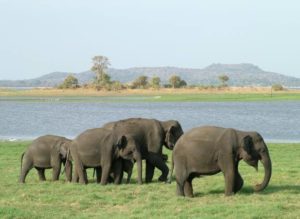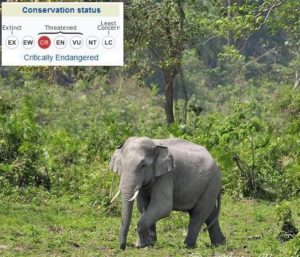 The Asian Elephant or Asiatic Elephant (Elephas Maximus) is the only living species of the genus Elephas and is distributed in Southeast Asia from Nepal and India in the west to Borneo in the east. Asian elephants are the largest living land animals in Asia. Three subspecies are currently recognised: the Sri Lankan Elephant, the Indian Elephant and the Sumatran Elephant.
The Asian Elephant or Asiatic Elephant (Elephas Maximus) is the only living species of the genus Elephas and is distributed in Southeast Asia from Nepal and India in the west to Borneo in the east. Asian elephants are the largest living land animals in Asia. Three subspecies are currently recognised: the Sri Lankan Elephant, the Indian Elephant and the Sumatran Elephant.The average shoulder height of females is 2.4 m and average weight is 2.7 tons, while average shoulder height of males is 2.75 m and average weight is 4 tons.
 The distinctive trunk is an elongation of the nose; the nostrils are at its tip, which has a one finger-like process. The trunk is a highly sensitive multipurpose prehensile organ and contains as many as 60,000 muscles.
The distinctive trunk is an elongation of the nose; the nostrils are at its tip, which has a one finger-like process. The trunk is a highly sensitive multipurpose prehensile organ and contains as many as 60,000 muscles.Tusks serve to dig for water and minerals; to debark and uproot trees and as levers for maneuvering fallen trees. It is also used for display and as weapon for offense and defense. Elephants are either right or left tusked. Female Asian elephants usually lack tusks; a small tusk like tooth can sometimes be found, known as “Tushes”.
 Asian Elephants are highly intelligent and self-aware. They have a very large and highly convoluted neocortex, a trait also shared by humans, apes and certain dolphin species. They exhibit a wide variety of behaviours, including those associated with grief, learning, mimicry, play, altruism, use of tools, compassion, cooperation, self-awareness, memory, and language.
Asian Elephants are highly intelligent and self-aware. They have a very large and highly convoluted neocortex, a trait also shared by humans, apes and certain dolphin species. They exhibit a wide variety of behaviours, including those associated with grief, learning, mimicry, play, altruism, use of tools, compassion, cooperation, self-awareness, memory, and language.Elephas Maximus has been listed as Critically Endangered by the International Union for Conservation of Nature (IUCN) as the population has declined by at least 50 percent over the last three generations, estimated to be 60–75 years. Asian elephants are primarily threatened by degradation, fragmentation, loss of habitat, and poaching (for their Ivory).

